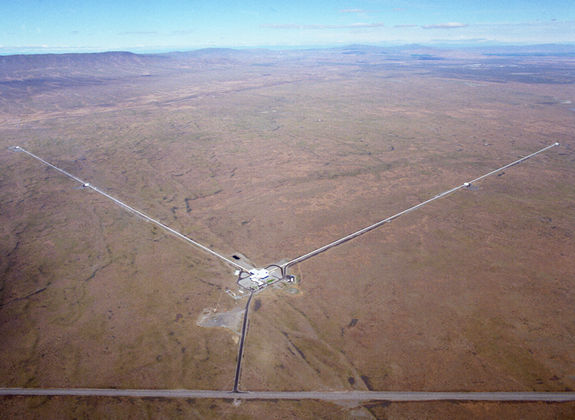Credit & Copyright: LIGO, Caltech,
NSF
Explanation:
Accelerate a charge and you'll get
electromagnetic radiation: light.
But accelerate any mass and you'll get
gravitational radiation.
Light is seen all the time, but, so far,
a confirmed direct detection of
gravitational radiation has
yet to be made.
When absorbed,
gravitational waves (GWs) create a
tiny symmetric jiggle similar to squashing a
rubber ball and letting go quickly.
Separated detectors can be used to discern
GWs from everyday bumps.
Powerful astronomical GW sources would coincidentally
jiggle even detectors on opposite ends of the Earth.
Pictured above are the two-kilometer-long arms
of one such detector: the
LIGO Hanford Observatory in
Washington,
which recently achieved a
phase-lock milestone to future GW detection.
When it and its
sister interferometer in
Louisiana
come online in 2002, they may see a
GW sky so
strange it won't be immediately understood.
APOD mourns the recent passing of
Joseph Weber, a visionary thinker and pioneer in
gravitational wave detection.
1999 2000 2001 2002 2003 2004 2005 2006 2007 2008 2009 2010 2011 2012 2013 2014 2015 2016 2017 2018 2019 2020 2021 2022 2023 2024 2025 |
Yanvar' Fevral' Mart Aprel' Mai Iyun' Iyul' Avgust Sentyabr' Oktyabr' Noyabr' Dekabr' |
NASA Web Site Statements, Warnings, and Disclaimers
NASA Official: Jay Norris. Specific rights apply.
A service of: LHEA at NASA / GSFC
& Michigan Tech. U.
|
Publikacii s klyuchevymi slovami:
gravitational radiation - LIGO - gravitacionnye volny - observatoriya LIGO - gravitacionnoe izluchenie
Publikacii so slovami: gravitational radiation - LIGO - gravitacionnye volny - observatoriya LIGO - gravitacionnoe izluchenie | |
Sm. takzhe:
Vse publikacii na tu zhe temu >> | |
